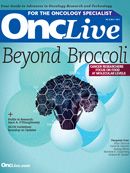Publication
Article
Fine-Tuning Cancer Care: NCCN Changes 11 Guidelines
Author(s):
Highlights on updates to the clinical practice guidelines from the annual National Comprehensive Cancer Network (NCCN) conference

The bond between bevacizumab and vascular endothelial growth factor.
More than 1800 oncology specialists and other healthcare professionals turned out for the annual National Comprehensive Cancer Network (NCCN) Clinical Practice Guidelines & Quality Cancer Care conference, held in Hollywood, Florida, from March 9-13. Here are highlights on updates to the clinical practice guidelines:
New Options for Metastatic Breast Cancer
Eribulin (Halaven) has been added as a preferred single-agent option in the treatment of metastatic disease, while bevacizumab (Avastin), in combination with paclitaxel (Taxol), continues to be endorsed as treatment for patients with stage IV breast cancer. Denosumab (Xgeva) has been included in the guidelines as an additional option for the prevention of skeletal-related events.
A footnote was added discouraging axillary lymph node dissection in certain women with early breast cancer and a minimal number of positive lymph nodes. And, with available study results deemed inconsistent, testing for CYP2D6 polymorphisms in order to determine the efficacy of tamoxifen is not recommended at this time.
Timeline for CML Therapy Advanced
The second-generation tyrosine kinase inhibitors (TKIs) nilotinib (Tasigna) and dasatinib (Sprycel) are now recommended as first-line treatment for chronic myelogenous leukemia.
In monitoring response to therapy, complete cytogenic response remains the gold standard; however, not achieving complete molecular response should not be considered as treatment failure.

Photo shows in situ hybridization of labeled DNA, a known oncogene, that has been put into a mouse oocyte, where it paired with RNA (black dots in nucleus of immature cell).
HPV Testing for Head and Neck Cancer Endorsed
The guidelines now suggest that patients with oropharyngeal tumors be tested for the human papillomavirus (HPV). The guidelines also suggest that patients with hypopharyngeal cancer be evaluated and started on speech therapy as soon as possible to avoid severe speech impairment as the disease progresses.
However, the issue of induction theory remains contentious, so the guidelines have not changed in that regard. The ongoing DeCIDE trial is expected to determine whether induction therapy is beneficial.
Multiple Changes in Melanoma Strategy
Following the conference, the FDA approved ipilimumab (Yervoy) for the treatment of metastatic melanoma. On April 1, the NCCN added ipilimumab to the guidelines as a category 1 treatment option (ie, based on high-level evidence from randomized controlled trials) for patients with advanced or metastatic melanoma, although a footnote was added to warn of possible significant immunemediated complications.
Mitotic index, the single most important predictor of survival, now replaces Clark level in defining clinical stage IB melanoma.
The guidelines have been updated to note that routine imaging is no longer recommended for stage IIA melanoma patients with negative lymph nodes. Previous guidelines noted that this decision was left to the discretion of the clinician.
A footnote was added to the section regarding the use of interferon alfa in the adjuvant treatment of stage III disease, indicating that the drug can be given as high-dose interferon for 1 year or peginterferon alfa-b for 5 years.
Although there is no hard-and-fast rule about which patients should have one, physicians should discuss the possibility of sentinel lymph node biopsies with patients who have stage IB or stage II disease.
Multiple Myeloma Guidelines Adjusted
The serum-free light chain assay and the fluorescence in situ hybridization for 1q21 amplification are now a recommended part of the initial diagnostic workup.
The combination of bortezomib/cyclophosphamide/ dexamethasone has been added as primary induction therapy for transplant candidates. The bortezomib/dexamethasone combination and the melphalan/prednisone/lenalidomide combination have been included as therapy for primary induction for nontransplant candidates.
The combinations of cyclophosphamide/bortezomib/ dexamethasone and cyclophosphamide/lenalidomide/ dexamethasone are now recommended for salvage therapy. The combinations of bortezomib/ dexamethasone and cyclophosphamide/thalidomide/ dexamethasone have been added to the guidelines as initial treatment for amyloidosis.
Quick Quote

Patricia J. Goldsmith
NCCN executive vice president and chief operating officer
Are there plans to add any cancer centers to the existing 21 member institutions?
No. While I think that virtually every comprehensive cancer center in this country has at one time or another asked for membership into NCCN, there is currently a moratorium on membership, and that has been the case for the last 2 years. We receive requests from cancer centers all across the world. Ultimately, we may consider some sort of international membership. But right now, there are no plans to add any cancer centers into the existing membership structure.
The reasons for this are several-fold. All of our 21 member institutions pay very significant membership dues and are required to volunteer hours on many different committees. For example, last year the NCCN guidelines panel members from our 21 member institutions donated more than 16,800 hours of volunteer time—not including travel—just in the development and maintenance of the guidelines.
Those cancer centers that have been with us since the beginning feel that NCCN has become very influential and prominent, and they don’t want to dilute the organization that they have worked very hard to build with their resources. Plus, the organization feels that, geographically speaking, most of the map is covered, so we would only consider additional members if we felt that they brought great value to NCCN as a whole.
Role of CSF in Myeloid Growth Considered
A revised footnote to the guidelines now states that there is a slight excess risk of acute myeloid leukemia and myelodysplastic syndromes in patients who have received colony-stimulating factors (CSFs) for chemotherapy-associated febrile neutropenia. In addition, the guidelines now recommend that primary prophylaxis with granulocyte CSF should be considered in patients who receive cabazitaxel chemotherapy for metastatic prostate cancer.
Honing Approaches to Non-Hodgkin Lymphomas
A new guideline has been added for post-transplant lymphoproliferative disorder; recommended treatment options include reduction of immunosuppression, single-agent rituximab (Rituxin), and chemoimmunotherapy.
The combination of rituximab and bendamustine (Treanda) is now recommended as first-line therapy for follicular lymphoma. The updated guidelines also indicate that positron emission tomography scans might be useful in certain patients with grades 1 to 2 follicular lymphoma.
EGFR Testing for NSCLC Recommended
The evaluation process for non—small cell lung cancer (NSCLC) now requires that the histologic subtype (ie, adenocarcinoma, large cell carcinoma, NSCLC not otherwise specified) be established before continuing with epidermal growth factor receptor (EGFR) testing. The testing is not recommended for squamous cell carcinoma, which has an incidence of EGFR mutations of >3.6%.
A clarification states that erlotinib (Tarceva), recommended as fi rst-line systemic therapy in patients with 3 histologies (ie, adenocarcinoma, large cell carcinoma, and NSCLC not otherwise specified) and a positive EGFR mutation, should be for patients with a 0 to 4 performance status. The updated guidelines also include gefitinib (Iressa) as first-line therapy in these same patients.
NSCLC patients should be tested for KRAS mutations, as these mutations are associated with tyrosine kinase inhibitor (TKI) resistance, thereby limiting the effectiveness of TKIs such as erlotinib and gefitinib. For patients not at high risk, the guidelines do not recommend routine lung screening tests with computed tomography until more data are accumulated.
Noteworthy Changes for Ovarian Cancer
Dose-dense paclitaxel has been added as a category 1 option for first-line treatment of stage II, III, or IV epithelial ovarian cancer.
Intraperitoneal (IP) chemotherapy should now be used in patients with stage III disease. Also, IP chemotherapy can be used in optimally debulked (ie, tumor ≤1 cm) stage II patients.
The guidelines continue to recommend that borderline epithelial ovarian cancer with low malignant potential be managed primarily by surgery. For women who want to remain fertile, surgery limited to unilateral salpingo-oopherectomy is still recommended. For those whom fertility is not important, the guidelines continue to recommend standard ovarian cancer-debulking surgery.
Bevacizumab (Avastin) is not yet recommended as upfront therapy with carboplatin/paclitaxel or as maintenance therapy.
Although biomarkers continue to show promise in predicting future patterns of disease, the data on the utility of routine monitoring of CA-125 levels are inconclusive at this point. As a result, the guidelines encourage clinicians and patients to discuss the pros and cons associated with the routine monitoring of CA-125 levels.
Big Changes in Prostate Cancer Care
Active surveillance (ie, watchful waiting) was made more rigorous for men with low-risk prostate cancer.
Sipuleucel-T (Provenge) has been added to the guidelines as an immunotherapy for asymptomatic or minimally symptomatic castrate-resistant metastatic prostate cancer. Symptomatic men, however, are not candidates for sipuleucel-T and should be considered for docetaxel/prednisone chemotherapy.
Cabazitaxel (Jevtana) has also been added as a new second-line therapy for men with hormone-refractory metastatic prostate cancer who have failed docetaxel.
As an alternative to zoledronic acid (Zometa), denosumab is now recommended for the prevention of skeletal-related events.
New Pathways for Sarcomas Identifi ed
A new observation pathway has been added to the resectable desmoid tumors section of the guidelines. Watchful waiting is less controversial with desmoid tumors because they do not metastasize as prostate cancer does. In addition, a new treatment pathway for these tumors has been added; it includes the options of surgery and/or radiation therapy and/or systemic therapy.
The NCCN staging system for sarcomas now classifi es lymph node involvement as stage III, not stage IV.
Molecular profi les and markers will become increasingly important to aid in the diagnosis, prognosis, and treatment of sarcomas.









